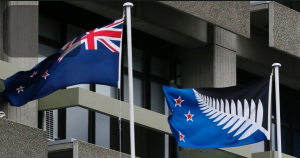The largest community event of them all in 1990 however was hosted in Auckland, the XIV1990 Commonwealth Games.
New Zealand had hosted these Games only twice before. 2826 athletes and officials from 55 participating Commonwealth nations attended, setting a new Commonwealth record.
For their duration, the Games gripped the attention of the country and were a huge success for New Zealand, ending fourth on the medal table behind giants like Australia, England and Canada.
Our medal haul of 58 medals included 17 Gold Medals and 14 Silver Medals, a significant reward for New Zealand which had always staunchly supported the Games’ continued development and relevance since their inception as the Empire Games at Hamilton, Ontario in 1930.
Maori cultural assertiveness also came to the fore during the Games, with a gigantic Maori cultural performance dominating the opening ceremony. This included dramatic depictions of Maori creation mythologies including the separation of Ranginui and Papatuanuku, starring the acclaimed Maori actor Temureua Morrison. New Zealand’s ethnic diversity also came to the fore, featuring peoples who had slowly found their way into New Zealand’s collective national memory.
During the opening ceremony, a magnificent gala of cultural diversity was performed by local ethnic groups with dance, music and costumes on display, leaving few in doubt as to the vibrancy of cultural variation in New Zealand.
Countless tourists also came from all over the world and especially from the ‘old empire’ to see the country that had once been described, 150 years earlier, as one of Britain’s ‘most recent and troublesome acquisitions’. The 1990 Commonwealth Games theme song – This is the Moment – also succinctly captured the ‘Huia Tuia Tui Tuia’ sentiment and was well received by our international visitors.
Remembering Empire
According to Tom Newnham, 1990 represented more than just the 150th anniversary of the Treaty signing. One hundred years earlier, under John Ballance’s Liberals, New Zealand had established itself as a welfare state.
Our electoral system was also now 100 years old. 1990 was the 150th anniversary of the founding of Auckland, Whanganui and Wellington and, within a year, New Plymouth. Finally, 1990 represented the 75th anniversary of the Anzac Gallipoli landings in Turkey during the Great War.
Though these and no doubt other anniversaries did feature in 1990, however, there was little doubt that, to most people, New Zealand’s Treaty relationship, and our past relationship with Empire, would provide a dominant focus throughout the sesquentennial year.
Sarah Campion remembered Māori visiting her childhood home in Kaipara, sitting in cane chairs on wide verandahs. But they seldom ventured into the drawing room where the ‘atmosphere of Home (England) was carefully preserved’. In those days, she wrote, the Treaty of Waitangi was ‘not the awkward issue it is today.’
Legal historian David Williams recalled his great grandfather – William Williams – who was a blacksmith, not a missionary, from Gloucester who brought his family to the Hawkes Bay area in the 1870s. As a boy, he remembered grandparents who were ‘extremely proud of their loyalty to the British Empire.’ Everyone referred with obvious warmth to Britain as ‘Home’.
Diplomat Denis McLean described New Zealand in 1990 as an ‘isolated place’ that was ‘joined inexorably to the fevered ebb and flow of human history.’ For too long, New Zealanders had thought of themselves as living ‘in some off-shore island of Europe.’
However, whereas the first colonists had started out with ‘no notion of themselves other than displaced Britons’; this was no longer the case. New Zealanders now needed to understand each other and the different cultures that infused the ‘brooding physical presence’ of this land.




